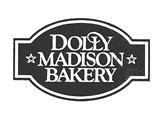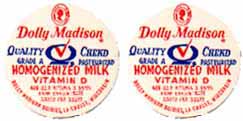Let's start with the fact that it is confusing to have so many different names:
Dolly, Dolley, even Dorothy and Dorothea. If you go to your local library you
will find books on both Dolly Madison and Dolley Madison. Some of her
biographers insisted that her given name was Dorothea, others wrote that it was
really Dorothy - although generally in their book titles they bowed to the
convention of Dolly.
Her original name was Dolley Payne, then Dolley Payne Todd, and finally Dolley
Payne Madison. She usually signed her letters: D P Madison. But her first
book-length biographer, Lucia B. Cutts, entitled her 1886 book The Memoirs and
Letters of Dolly Madison, and set the pattern of spelling her name "Dolly."
Lucia B. Cutts was DPM's grand-niece, so it seemed logical that however she
spelled her great-aunt's name must be correct. By 1896 Maud Wilder Goodwin
entitled her biography Dolly Madison, but explained to the reader that DPM
really had been named "Dorothea in honor of Dorothea Spotswood Dandridge,
daughter of Nathaniel West Dandridge, and grand-daughter of the long remembered
Governor Alexander Spotswood." Thus "Dolly" was consigned to a "nickname," not
a Christian name. In 1909 Ella Kent Barnard published a book devoted to DPM's
Quaker background entitled Dorothy Payne, Quakeress; a side-light upon the
career of "Dolly" Madison. But in 1914 Allen C. Clark, who was then president
of the Columbia Historical Society, published Life and Letters of Dolly
Madison, and reverted to the assertion that DPM's real name was Dorothea after
Dorothea Spotswood Dandridge, although "Dorothea was quickly changed to Dolly."
Thus Dolley became known as Dolly, and by the early 20th century products began
to be named "Dolly." Soon there was Dolly Madison Ice Cream and a Dolly
Madison Dairy. There were companies producing Dolly Madison luggage, Dolly
Madison hats, and Dolly Madison shoes. By the mid 1950s the Encyclopedia
Britannica called her Dorothy; the Encyclopedia Americana referred to her as
Dolly; and the Reader's Encyclopedia said she was Dorothea. Although the
encyclopedic biographer of James Madison, Irving Brant, claimed she was really
named Dolley as early as 1950, no one listened.
And then in 1958 the Smithsonian added Dolley Madison's 1809 inaugural gown to
its first ladies exhibit. Margaret Brown Klapthor, then associate curator of
history at the Smithsonian, believed that the correct spelling of DPM's name
was Dolley, but to make sure she contacted the newly-established Papers of
James Madison. Was her name Dolly - or Dolley? The staff of the Papers
answered resoundingly that Mrs. Madison spelled her name with an "e." The news
was important enough in 1958 to make the front page of The New York Times on
April 13, and it was noted as well in the April 21 issue of Time Magazine.

The
Papers of James Madison had settled the issue. Their scholarship was
irrefutable, and since then biographers and scholars have spelled her name with
an "e." The business world, however, had established their products with
copyright and registered their names with trade marks and created their
reputations with the use of the name "Dolly." They were not about to change
their spelling with the times. And so today we have Dolley Madison the
historic figure and Dolly Madison the product name.


This leaves us with the question: what's in a name? There is the story of
historical accuracy triumphing over legend. But that simply leaves us with the
problem of why the myth of "Dolly" arose in the first place.
Her early years are shrouded in mystery and the many blanks have been filled
with myths, oral histories, and family legends - some of which were of her own
making. In August 1834, she wrote a friend who had been commissioned to write
a biographical sketch of her: "My family were all Virginians except myself,
who was born on a visit of one year to an Uncle." Eager to be included among
the first families of Virginia, Mrs. Madison explained that "their families on
both sides, were among the most respectable citizens of the state." The truth
is that the Payne family had moved to North Carolina, and that her next oldest
brother, William Temple Payne, had been born there too. But DPM wanted to
belong to one of Virginia's finest families, and so as she reconstructed her
past.
The story of her name is part of that tale. The name "Dolley" is not refined.
It was perhaps even a bit silly and girlish and certainly had neither stature
nor elegance. So like the story of her birth, her name too was changed.
Biographers could not simply refer to her as Mrs. Madison -- they had to tell
about the childhood of DPM. They needed a childhood name. But they could, and
did, turn the problem into an opportunity. Her niece, Mary E. E. Cutts, first
did so in the fragmentary memoir she wrote before her own death in 1854. She
explained simply that "the subject of this memoir" was "named Dorothy in
compliment to her mother's aunt Mrs. John Henry." But, Ms. Cutts went on, "as
she grew up the name was growing out of fashion, so she ever afterwards wrote
it Dolley and so she was called." Thus, while Mary E. E. Cutts did not change
the spelling of her aunt's name, she did create the myth of Dorothy (or
Dorothea). Lucia B. Cutts then took Mary E. E. Cutts memoirs, and cut,
bowdlerized, and edited the text into her own published biography. In the
process she changed Dolley's name to Dolly. And so it remained until 1958.
Woven into a name are many pictures. There is the portrait of a woman who
wanted to be a fine Virginia lady, and not the daughter of a failed planter who
manumitted his slaves, moved his family to Philadelphia, and failed again, only
this time as a starch merchant. There is the impression of her descendants,
who like their ancestor, wished her to have an illustrious, even noble, past.
There is the image of her biographers, who like members of the Payne family,
desired Mrs. Madison to be great, and believed that a "correct" genealogy would
add luster to her name. Contemporary scholars tend often to be interested in
the process of the invention - and reinvention - of self, and this story is
certainly illustrative of that process. But it contains as well another tale
-- the importance of getting the facts correct.